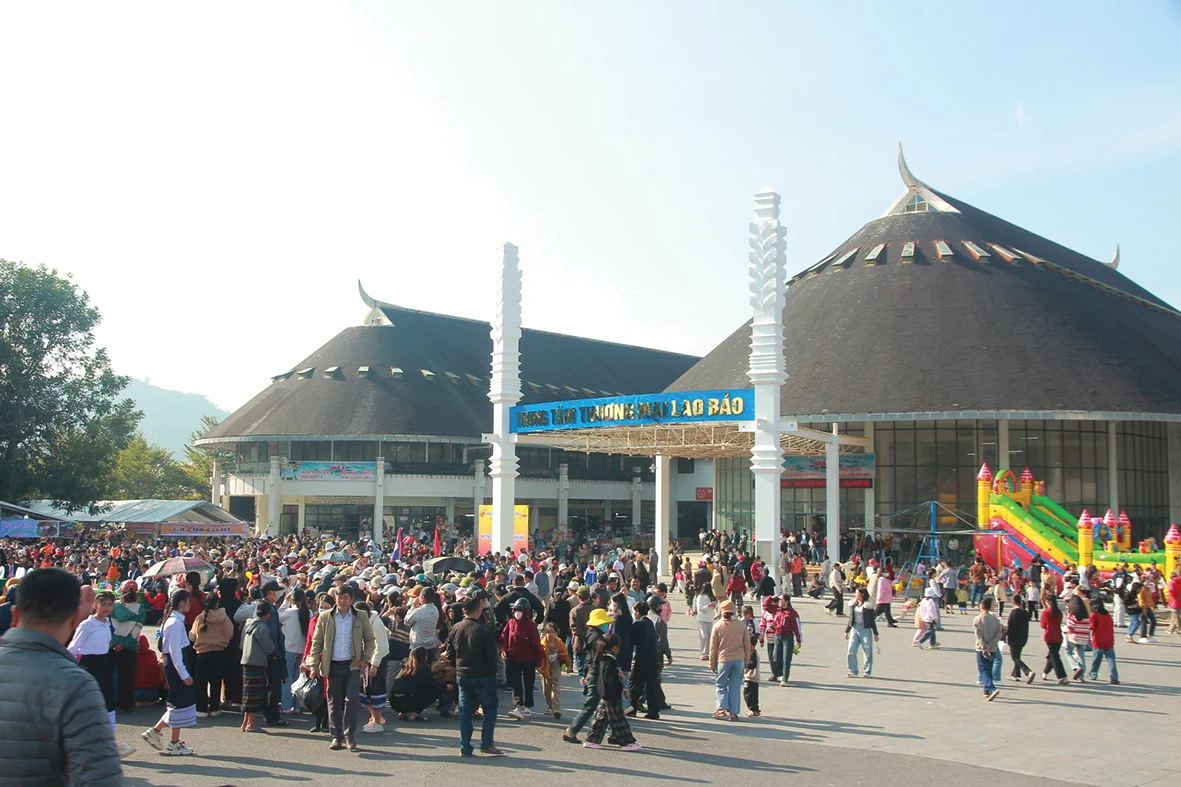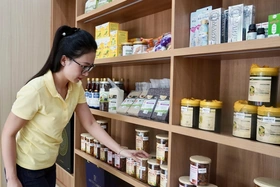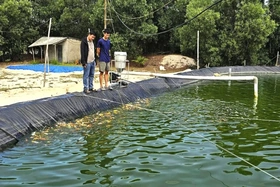{title}
{publish}
{head}
The Quang Tri Provincial Planning for the period 2021–2030, with a vision to 2050, outlines the goal of developing Quang Tri into a province with a strong economy primarily driven by industry and services. It aims to become one of the key growth engines of the North Central and Central Coastal regions of Vietnam.
To realize this development goal and move forward with the country into a new era, Quang Tri has been actively expanding its development space westward. The province is strategically leveraging the advantages of the East-West Economic Corridor (EWEC), which connects the Pacific Ocean to the Indian Ocean, as well as the Quang Tri (Vietnam)–Salavan (Laos)–Ubon Ratchathani (Thailand) corridor. Together, these routes form the PARA-EWEC Corridor, running parallel to the EWEC, and open up new opportunities for regional economic cooperation and development.

Coal imported through the La Lay International Border Gate. Photo: N.T.H
Under the Implementation Plan to Promote Vietnam’s Investment in Laos to 2025, outlined in Official Document No. 2390 dated November 9, 2015 by the Government Office, enterprises from Quang Tri Province have effectively collaborated with local authorities in Laos to implement several investment projects. These include the rubber plantation project by Quang Tri Rubber One Member Limited Company in Sa Muoi District, Salavan Province, with a total investment of approximately 8.1 million USD; the Ecological Coffee Supply Chain Project by Slow Forest Coffee Company in Quang Tri Province, covering an approved area of 930 hectares; and electricity provision by Quang Tri Power Company for residential and production use across border regions in Savannakhet and Salavan provinces.
Quang Tri has also attracted investment from Laotian enterprises such as Lao Viet Energy Company, a subsidiary of Xekong Power Plant Company Limited. In the coal import-export sector through the La Lay International Border Gate (Quang Tri)-La Lay (Salavan), Vietnamese and Laotian investors have conducted research and proposed infrastructure projects. The approved investment policy includes a conveyor belt system for coal transport, loading and unloading yards, coal storage facilities, and related transport services and infrastructure. The volume of coal imported from Laos to Vietnam could reach up to 500 million tons over the next 50 years.
Quang Tri Province has a long-standing tradition of cooperation with its Lao border provinces, Savannakhet and Salavan, across various sectors, and since 2023 has begun signing cooperation agreements with Champasak and Sekong. Notably, in economic, trade, and tourism collaboration and the development of the PARA EWEC Corridor (parallel to the East-West Economic Corridor - EWEC), Quang Tri has proactively worked with Savannakhet to develop a proposal for a Lao Bao–Densavan cross-border economic and trade zone. This proposal has been submitted to the competent authorities of both countries for approval, aiming to leverage Quang Tri’s strategic location at the gateway of the EWEC on the Vietnamese side and to drive socio-economic cooperation between Quang Tri and Savannakhet.
This trade zone is envisioned as a new-model “free trade zone” with unified preferential mechanisms and policies beyond each country’s existing legal frameworks. It aims to attract investors, facilitate business operations, and ease movement and trade activities for residents within the zone.
The road linking National Highway 9 from Ban Dong—the starting point of the Densavan border trade zone in Laos—to Ta Oi District in Salavan Province, continues to connect with National Highway 15B from the La Lay International Border Gate to Salavan, Sekong, and Champasak provinces. This area is home to the large coal reserve Kaleum mine and the Boloven Plateau, known for its agricultural potential in Southern Laos. The completion of this route has opened up a new transport corridor and a space for cooperative development along the Vietnam-Laos border.

The border market at the Lao Bao Trade Center attracts visitors for sightseeing and shopping. Photo: T.H
Between 2025 and 2030, Quang Tri will continue to strengthen cooperation with Lao provinces in sectors where it has comparative advantages such as agriculture, agro-forestry processing, mining, trade, infrastructure construction, transport services, and logistics. These are also areas where Lao provinces are eager to collaborate, generating new momentum for socio-economic development in the border region between the two countries.
Quang Tri’s advantageous geographic location places it at the midpoint of Vietnam, adjacent to the central economic region, and at the intersection of the North-South and East-West transport axes. The province boasts a comprehensive transport system—road, rail, waterway, and air—making it a vital link in regional economic cooperation, international trade, logistics, and interregional and cross-border tourism and commerce. Since 1998, Quang Tri has actively participated in the Greater Mekong Subregion (GMS) cooperation program and its associated corridor development initiatives.
In recent years, the province has focused on improving the investment environment and infrastructure, especially transport connectivity, to maximize its role as Vietnam’s gateway on the East-West Economic Corridor linking Laos, Thailand, and Myanmar. Quang Tri is now a major construction hub, attracting key projects that are transforming it into a regional and international logistics center. These include the My Thuy Port Complex; Quang Tri Airport; the coastal road connecting to the EWEC; Quang Tri Industrial Park; the VSICO Inland Port; CFG Nam Cua Viet Port; and the coal transport conveyor system project from Laos to Vietnam.
In addition, major transport projects are being implemented to enhance regional connectivity, such as the coastal road linked to EWEC, the eastern bypass of Dong Ha City, the Cam Lo–La Son Expressway, and the Cam Lo–Van Ninh Expressway. Investors are also exploring strategic transport projects under public-private partnership (PPP) models, including the proposed Cam Lo–Lao Bao Expressway and National Highway 15D upgrades.
In parallel with leveraging EWEC’s advantages, Quang Tri has actively collaborated with Salavan and Champasak (Laos), and Ubon Ratchathani (Thailand) to propose that their respective governments approve the PARA EWEC initiative. At the same time, provinces along the corridor are accelerating investment in transport infrastructure, logistics facilities, and international border gate upgrades, while streamlining administrative procedures to facilitate smooth and efficient movement of people and goods.
Quang Tri has also proposed that the Vietnamese and Laotian governments approve the development of the La Lay (Quang Tri)–La Lay (Salavan) Border Economic Zone, to tap into each province’s strengths. In the 2025–2030 period, Quang Tri will focus on attracting investment to complete National Highway 15D, connecting the La Lay International Border Gate with My Thuy Deep-Sea Port. This new route is expected to play a significant role in boosting the socio-economic development of southwestern Quang Tri and in promoting the overall development of the EWEC.
The East-West Economic Corridor is identified as one of the key corridors in Resolution No. 26-NQ/TW dated November 3, 2022, of the Politburo on socio-economic development and defense-security in the North Central and Central Coastal regions to 2030, with a vision to 2050, as well as in the National Master Plan for the 2021–2030 period.
Once operational by the end of 2025, My Thuy Deep-Sea Port in Quang Tri will reduce the distance for cargo transport on the EWEC and PARA EWEC to the Pacific Ocean by around 150 kilometers compared to Da Nang. This will enhance regional connectivity and expand Quang Tri’s development space westward
Resolution No. 26-NQ/TW dated November 3, 2022, issued by the Politburo on the development of socio-economic conditions and the safeguarding of national defense and security in the North Central and Central Coastal regions through 2030 with a vision to 2045, clearly states: “Promote economic cooperation through border gates within the region in connection with the East-West Economic Corridor. Explore a pilot model of a cross-border economic zone along the East-West Economic Corridor.”
Along the 2,067-kilometer Vietnam–Laos border, eight pairs of international border gates have been established, including two in Quang Tri Province: Lao Bao and La Lay international land border gates.
Recognizing the strategic position of National Route 9 and the favorable natural conditions around the Lao Bao (Quang Tri, Vietnam) and Densavanh (Savannakhet, Laos) international border gates, in 1997, the Politburos of the Communist Party of Vietnam and the Lao People’s Revolutionary Party agreed in principle to study the development of the Lao Bao–Densavanh area into a “Free Trade Zone” with exceptional preferential mechanisms and policies, aiming to create a breakthrough in socio-economic development.
Thanh Hai - Ngoc Mai

QTO - In Quang Tri, clean agricultural stores may not flaunt flashy signs or wide storefronts, but they are quietly becoming trusted places where consumers...

QTO - In a quiet village in central Vietnam, Le Minh Duc, 26, has turned his passion for ornamental fish into a promising startup, the first Koi breeding...